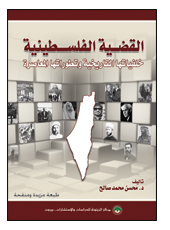Al-Zaytouna Centre for Studies and Consultations has issued a new book in Arabic titled: The Palestinian Issue: Historical Background and Contemporary Developments by Prof. Dr. Mohsen Mohammad Saleh.
This 208 page medium sized book presents a general overview of the Palestinian issue, by tracing its historical junctures and its current developments. For the reader, this will facilitate his comprehension of its overall picture, the intertwined factors connected to it, at any stage and in a logical sequence, up to the present stage.
| Publication Information:
Title: Al-Qadiyyah al-Filastiniyyah: Khalfiyyatuha al-Tarikhiyyah wa Tatawwuratuha al-Mu‘asirah (The Palestinian Issue: Historical Background and Contemporary Developments) |
This book is of special importance to the group of readers who wish to get a general idea of the Palestinian issue, or those who do not find time for detailed specialized studies. The book is written in a smooth Arabic language, and is full of information updated till mid 2011; all the while retaining a scientific, academic and documented wording, far from emotional structural discourse.
In its first chapter, the book deals with the backgrounds of the Palestinian issue up to 1918. It reviews Palestine’s history through the ages, its geography, its Islamic standing, and the Jews’ religious and historical claims to it, up to the emergence of the Palestinian issue in modern history, in addition to its political developments up to the end of World War I in 1918.
The second chapter highlights the period of the British occupation of Palestine during 1918–1948. It discusses the development of the Zionist project, the emergence of the Palestinian national movement and the 1936 revolt, as well as the political events that followed, up to the 1948 war and its implications.
The third chapter reviews the issue’s developments during the period 1948-1967, focusing on the development of the Palestinian national movement, the rise of Fatah movement and the Palestinian Liberation Organization (PLO), and the war of June 1967 and its implications.
As for the fourth chapter, it addresses the period 1967–1987 up to the outbreak of the first Intifadah in 1987, shedding light on the emergence of the Palestinian national identity, the development of the Palestinian armed struggle, the Arab countries’ role in the Palestinian issue, and the emergence of the Palestinian Islamic Resistance Movement (Hamas).
The fifth chapter deals with the period starting with the outbreak of the 1987 Intifadah until the failure of the Camp David negotiations in 2000, going through the emergence of Hamas, the transition of the PLO from armed struggle to peaceful settlement, the formation of the Palestinian National Authority, and the developments that Israel had witnessed during the same period.
The last chapter in the book reviews the developments that occurred following the outbreak of al-Aqsa Intifadah in September 2000 and until mid 2011. It is divided into subjects that include the Palestinian resistance, the Palestinian internal situation, the path of the peaceful negotiations, Jerusalem and the current status, the Separation Wall, and the Israeli internal situation.





Do you have the mentioned book in a pdf format? Kindly advise.
Yes we do, you can buy it via this link: https://eng.alzaytouna.net/product/the-palestinian-issue-historical-background-contemporary-developments/